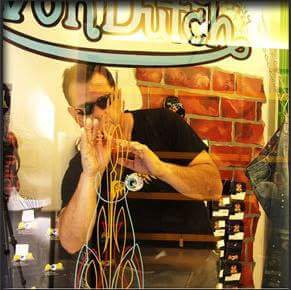Hand-painted pinstriping is a meticulous and artistic technique that involves applying thin lines, curves, and intricate designs to various surfaces, typically using enamel paints and specialized brushes. This intricate form of decoration adds a touch of elegance, personality, and flair to objects like vehicles, motorcycles, helmets, guitars, and even household items.
Historical Significance:
The historical significance of hand-painted pinstriping can be traced back to the early 20th century when it was initially used to adorn horse-drawn carriages. As the automobile industry emerged, this art form transitioned to cars, where it became particularly popular in the custom car and hot rod scene during the 1950s and 1960s.

During this time, pinstriping gained a reputation as a symbol of personalization and craftsmanship. Skilled pinstripers would often work a car show, offering on-the-spot customization that showcased their talent and creativity. Pinstriping played a crucial role in transforming ordinary vehicles into eye-catching works of art, enhancing their visual appeal and reflecting the unique personality of the owner.
In addition to the automotive world, pinstriping also found its way into other artistic and cultural realms. Custom pinstriping designs were often featured on guitars, helmets, and even clothing, adding a touch of individuality to everyday items.
Artistic Expression:
Hand-painted pinstriping is not only about enhancing the appearance of an object but also about expressing the artistic vision and skill of the pinstriper. The process requires a steady hand, a keen eye for design, and an understanding of how to manipulate the brushes to create various line widths, curves, and angles. Each stroke is deliberate, and every design is a testament to the artist’s precision and creativity.
As technology advanced, vinyl decals and computer-generated graphics became more prevalent, leading to a decline in the popularity of hand-painted pinstriping. However, the enduring allure of this traditional art form lies in its authenticity, uniqueness, and human touch. While machines can replicate designs with perfect precision, they lack the imperfections and personal touch that make hand-painted pinstriping so captivating.
In recent years, there has been a resurgence of interest in hand-crafted and artisanal work, leading to a renewed appreciation for hand-painted pinstriping. Artists and enthusiasts continue to keep this tradition alive, reminding us of the beauty of craftsmanship, the value of individual expression, and the enduring appeal of a technique that carries with it, decades of history and culture.

